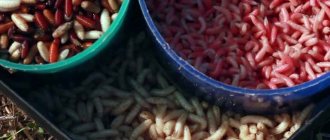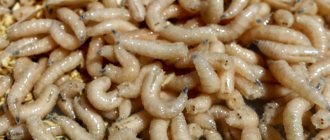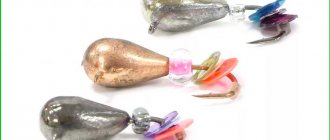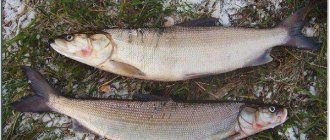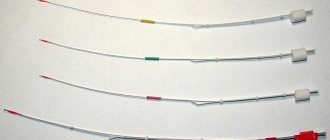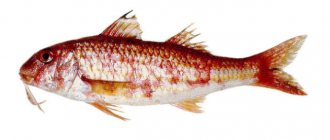Features of production and storage
Maggot is the larva of gray and blue flies. Using maggots for fishing is the most popular arsenal for most fishermen. Catching almost all white fish is not complete without baits of animal origin.
The great demand for this raw material for fishing has prompted many entrepreneurs to open a business that is not the most aesthetically pleasing. Breeding maggots for fishing does not require additional costs for raw materials and production. This is the cheapest investment option and a business with high profitability.
Creating the right microclimate is the main thing that a person who owns such an enterprise must maintain at a high level.
It requires:
- Availability of a special room (garage, basement, shed, shed).
- Maintaining temperature within +25 degrees.
- Maintaining humidity 50%.
- Well-established ventilation system.
- Feeding flies that lay larvae.
- Feeding the larvae themselves.
To preserve the “youth” of the nozzle, you only need to freeze it. Moreover, the suitable temperature lies in a narrow range from +2 to -2 degrees. This is the line that it is better not to cross.
Moreover, for an entrepreneur this process is not as problematic as for the fisherman himself. Having space for breeding, naturally, he also owns freezers. After white babies are born, they are screened by size and separated into jars or other containers. Before being placed in refrigeration units, maggots are sprinkled with wet sawdust. This way the packaged product can be stored for more than one month.
Minus periods transfer the larvae into suspended animation. At a low threshold level of up to -30 degrees, they can last up to 3-4 years in a frozen state.
Home storage
At normal temperatures, pupation may occur after a week, and later, transformation into flies. Proper storage will allow you to use the fishing attachment for another one to two months.
How to save maggots until your next fishing trip?
To do this, there is no need to resort to sophisticated nanotechnologies, since storing live maggots at home depends primarily on:
- Availability of a refrigerator.
- Availability of free space in the container.
The main thing is to observe the temperature regime. Just like in industrial production, it must be maintained close to zero or near zero negative temperature.
Each container must maintain a reserve area for life. Tightly wrapped individuals may stretch out and die.
Additional factors contributing to long-term storage:
- Closed from natural and artificial lighting.
- Cultivation, as well as storage of maggots, takes place on sawdust. This material is necessary to absorb excess moisture from the maggots themselves.
- It is better to deprive cooled larvae of access to oxygen, otherwise even in the refrigerator there is a possibility of pupation.
It is better to store the larvae in shavings of larch trees. Coniferous plants have a pungent smell of resin.
Representatives of different ages and species can have different life spans. The most tenacious are the young ones, with a dark spot near the head. And the red pinka variety is 1 cm long, very mobile, and can be stored in the refrigerator for up to six months.
Giving bait additional properties
Having figured out how to properly store maggots at home, you can resort to an additional fishing trick.
Before freezing, you can make it more attractive to fish by:
- aromatization;
- coloring
To obtain the desired smell, each fisherman uses his own secrets and ingredients.
Most often, one of two procedures is used:
- Attractants are sprayed into the sawdust.
- Sawdust is boiled in prepared aromatic water (with honey, dill, hemp).
For professional painting in private enterprises, red dyes “Sudan-3” or “Sudan-4” are used. Previously, only two colors were used: traditional white and red. Fishing experiments have led to the fact that now white worms are also painted yellow and green.
In industrial production, manufacturers use special tricks. To add color, dyes are added directly to the feed. And to obtain the fattest and meatiest individuals, their “mothers” are fed with meat and cottage cheese.
How to paint your home correctly:
- Egg yolk and food coloring are mixed into one substance. The liquid is poured into a container for maggots as food. Over time, the larvae acquire a new color.
- It is important to use quality dyes. Unsuitable taste and smell can scare fish away from their favorite delicacy.
“How to store maggots at home?” - a question faced by inexperienced fishermen who begin to “get involved” in the process. Senior colleagues are aware that there is no point in going to the store for new maggots every time when you can take a frozen version with you from your last fishing trip.
To ensure 100% home safety, it is important to pay attention to the original product purchased. After taking the jar from the seller, you should shake it. The fresh “product” has a bright white color and actively moves. Upon arrival for fishing, the frozen version should be placed in the sun, so the larvae will come to life faster.
Source: orybalke.com
Let's talk about the secrets of cleaning pike
How tasty and appetizing is fish soup made from fresh pike just caught in the river! But before you prepare any dish from it, you need to learn how to properly clean pike. We'll tell you step by step how to do this.
How tasty and appetizing is fish soup made from fresh pike just caught in the river! But before you prepare any dish from it, you need to learn how to properly clean pike. We'll tell you step by step how to do this.
What tools will be useful
In order to clean and fillet the pike you will need some kitchen tools.
- a sharp knife (how to properly sharpen and straighten a knife sharper than a razor can be read here) - this is very important,
- kitchen scissors, brush
- gloves,
- cutting board (preferably a special cutting board - for example, such as here),
- where to put dishes,
- a roll of paper towels and sometimes pliers (they are needed to pick up the skin).
Freshly caught pike is best filleted quickly, simply and easily.
Next, you should carefully gut the pike - remove the insides down to the black film.
How to quickly clean a pike - advice from an experienced fisherman [video]
Frozen pike is cleaned without defrosting, using a large kitchen knife. Special knives (Evenki and Yakut) are ideally and quickly cleaned, in which one side of the blade is smooth, the other is regular, wedge-shaped.
Fish cleaning
To master the skill of how to quickly clean a pike from scales, a video will come to the rescue and visually present the whole process. The sequence of actions when cleaning pike is as follows:
- First of all, the fish should be washed well.
- As already mentioned, a wide, sharp knife or scraper should be used to remove scales. Holding the pike by the tail, you need to use prying movements to move the scales in the direction from the tail to the head. The knife should be held at a slight angle so that the small husks remain on the knife blade and do not fly apart.
- Using scissors or the same knife, trim the fins of the fish.
- Then it is necessary to cut the cartilage located between the head and abdomen. You need to place the fish with its head towards you and make a puncture with a knife near the head, after which, moving towards the tail, gradually cut the abdominal cavity. This must be done extremely carefully so as not to damage the internal organs of the fish.
- The entrails should be removed and the gills removed using a knife (usually a long and narrow knife is used for this purpose).
- At the very end, the air bubble should be removed, and the white film that runs along the entire ridge should be removed.
- Finally, the cut pike carcass must be thoroughly washed both from the inside and from the outside.
By acquiring new skills on how to clean pike from scales, this process will seem completely uncomplicated.
It is known that many amazing dishes can be prepared from pike, for example, juicy fish cutlets or fried fillet pieces in batter. However, to make the dish really tasty, you should follow a certain sequence of actions during cutting, and also know how to clean the pike from the bones without damaging the fillet:
Using maggots when fishing
Maggots are mainly used for catching fish such as:
- crucian carp;
- carp;
- roach;
- asp;
- tench;
- perch.
It is best to use maggot in summer or late autumn. Its use for fishing has the following advantages:
- It greatly increases the chances of a bite, since the maggot, like the red worm, moves very actively in the water, which attracts many fish.
- Since maggot is a fly larva, many species of fish never refuse such a delicacy and peck at it.
- Maggot can be stored for quite a long time, so it is convenient as an attachment.
- Maggots can also be used as live bait, where they show excellent results.
- Maggots are easy to put on the hook and stay on it for a long time, which indicates their convenient use.
- Maggots can be used for catching with a bottom rod and a float rod. It works great in both gears.
- Maggots are quite common in fishing markets and are not very expensive, which, together with excellent working qualities, makes them quite popular among many fishermen.
- The larvae can be mixed into the bait mixture along with red worms. They have their own specific smell, which is very noticeable to fish.
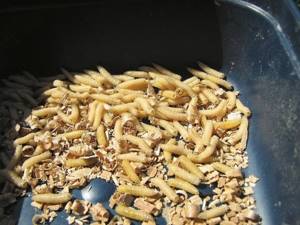
Advantages and disadvantages
This type of attachment undoubtedly has more pros than cons, and is very popular for good reason. The advantages of the bait include the following:
- maggots are very mobile, actively wriggle on the hook, which attracts fish well;
- they are easy to attach to hooks, they hold very tightly, which allows the use of both float and bottom gear;
- it is one of the main components for preparing various baits for predatory and peaceful fish;
- Maggot is very easy to store.
Despite all the advantages, there are also significant disadvantages. But they are relevant only when purchased, and not when grown at home. These include:
- deficit. Maggot is not sold in all fishing stores, and sometimes it is very difficult to find;
- price. As a rule, prices are greatly inflated, and the larger the larvae, the more money you will have to pay for them.
After weighing the pros and cons, many fishermen decide to grow larvae themselves. All that remains is to find out how to properly breed maggots.
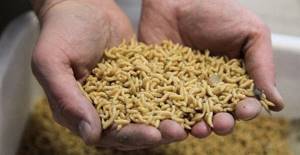
Many fishermen, guided by the desire to increase the attractiveness and catchability of the larvae, show their wildest culinary fantasies, resulting in new types of maggots used in fishing.
The recipe for pickled maggots was invented by English fishermen. The main goal was to ensure that the bait held more firmly on the hook. First, it is marinated in vinegar for an hour, after which it is dried using a regular napkin or additionally baked in the oven. This method can be applied to individuals that may soon deteriorate.
We suggest you read: How to make technoplankton without a press
Maggot with egg came to our country from Poland. It’s hard to say whether it performs better or worse in fishing conditions. Before fishing, the maggot should be fed the yolk of a hard-boiled egg. After being eaten, the worm turns yellow. For fans of this method, the question of how to feed maggots for fishing disappears.
Many fishermen are sure that only red maggot can be better than ordinary maggot. It is used by athletes in competitions, who have repeatedly confirmed the effectiveness of such bait. To color the bait, it is dipped in milk with beet juice or food coloring. Plain water with the addition of potassium permanganate, iodine, brilliant green or food coloring is also often used.
When it is not possible to store maggots in the right conditions, some fishermen freeze them and allow them to thaw before going fishing. Based on observations, this option is not very effective, since fish definitely respond better to live bait than to dead bait.
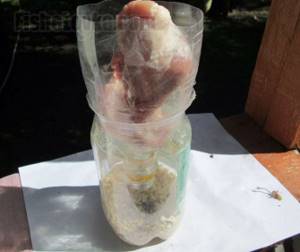
Boiled maggot worm is great for winter and summer fishing. To prepare it, throw it into hot, non-boiling water and take it out after 5-7 minutes.
It is also common to see artificial maggot substitutes. To make it, you need to cut pieces of foam rubber, soak them in egg white and throw them into boiling water. The result is baits that are slightly similar to the original.
A maggot is a fly larva.
How to grow maggots at home
There are many ways to grow maggots at home:
- For example, using a chicken egg:
- Boil three chicken eggs.
- Cool thoroughly.
- Remove the top shell from the egg and one centimeter of the white.
- Place it outside (under a tree, in any shade, etc.).
- Leave it in this position for several days (five to six) so that it becomes rotten and blue flies begin to fly to it.
- After this time, the flies should lay many larvae on their eggs, which will subsequently hatch into small, hungry maggots.
- You need to feed maggots with meat or raw fish.
- Using a bottle. For this method of breeding maggots, you should follow the following algorithm:
- Take a clean two-liter bottle (plastic bottles from beer or other drinks work very well).
- Carefully cut small holes about three centimeters in size on the top of this bottle.
- Throw chicken giblets (intestines, stomach, etc.) and pieces of pork or chicken meat into these holes at the bottom.
- Hang it in a well-sunny area.
- Leave in this position for four days. During this time, blue flies will lay enough larvae to form live maggots.
- Breeding maggots in the liver. To do this you should:
- Take a small piece of veal or pork liver (no more than half a kilogram).
- Make shallow transverse cuts on it so that blood flows from both sides.
- Place the liver on a strong hook and hang it at a high distance.
- Leave it for five days, then remove it and put it in a deep container with sawdust (a bucket with a lid works great), and wait a little longer.
- After just two days, you can collect ripe maggots.
- Breeding maggots in fish. To do this you need:
- Cut the raw fish a little, but do not remove the insides.
- Place it in a large bottle with holes and hang it in the sun in a remote place, because the decomposing fish will give off a terrible smell.
- Wait four days and then transfer the fish to a container with wood shavings.
- Feed the larvae meat with raw fish.
- Breeding on sawdust. To do this you need:
- Pour a small layer of sawdust into a bucket.
- Leave small pieces of meat in the sun so that flies have time to lay larvae on it.
- Carefully place the meat on the sawdust and sprinkle a little more on top.
- Wait five to six days, after which you need to use ready-grown maggots.
How to increase your fish catch? ">
Over 7 years of active fishing, I have found dozens of ways to improve the bite. Here are the most effective ones:
- Bite activator . This pheromone additive attracts fish most strongly in cold and warm water. Discussion of the bite activator “Hungry Fish”.
- Increased gear sensitivity. Read the appropriate manuals for your specific type of gear.
- Pheromone -based lures .
Large maggots using meat
. The next method is a little more complicated, but it will allow you to protect your home from the smell of rot, which is especially useful in an apartment, and will also protect your larvae from those who feed on them, that is, from various birds. To use you will need: Old (including rotten) fish or meat, paper or newspaper, an ordinary glass jar, and an elastic band.
First you need to place the rotten meat under the sun and give the flies time so that they have time to process the bait. After a couple of hours, the workpiece needs to be wrapped in paper several times and left at the bottom of the jar. To ensure the safety of the bait and eliminate odor, the neck should also be wrapped, and an elastic band should be used for tightness. After 3-4 days, our maggots will be ready.
Read: Secrets of fishing. Catching crucian carp with lard
How to store maggots
Storing maggots includes the following features:
- Maggot larvae should be stored at a temperature that is not far from zero. If they are kept in sub-zero temperatures, they will not be able to sustain their life and will soon die.
- You only need to store maggots in a well-dried container that has a tight lid (otherwise the larvae can simply spread throughout the refrigerator or other storage place, which will cause a number of problems).
- It is advisable for the larvae to “lie” on soft sawdust from any wood.
- Before putting the maggots in the refrigerator, you need to dry them a little. It is best to use very small shavings from a fruit tree (pear, apple tree, etc.) for this, which is sprinkled with the larvae. It is also very important that the chips have medium moisture content. This way, she won't be able to completely dry out the maggots and will keep them usable for several weeks. No later than after a week and a half, the sawdust should be replaced with new ones.
- The container for storing larvae must have small holes for air to enter.
- If stored properly, maggots can be absolutely usable for three months.
- In winter, maggots can be stored directly on the ground, but for this you need to prepare it a little. First you should sprinkle the ground with a good layer of sawdust and fill it with warm water. Then you need to place the maggots there and cover them with sawdust again, creating a kind of greenhouse zone for them.
- In addition, the larvae can be stored in a warm cellar that is well ventilated.
How to color and flavor bait
In order to properly flavor the maggot and give it a special smell, all kinds of aromatic agents are used.
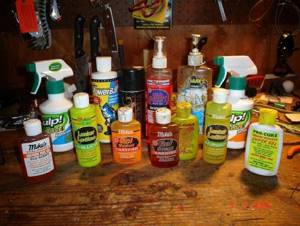
The most suitable components for this purpose are the following:
- garlic;
- dill;
- coriander;
- cocoa;
- vanilla;
- vegetable oil;
- Corvalol;
- decoction of sawdust.
Flavoring of maggot larvae occurs according to the following plan:
- Add a small amount of one of the ingredients to the pan and add water.
- Bring to a boil and season with a small amount of wood shavings.
- Leave to brew.
- When the broth has cooled, remove all the ingredients from the pan and sprinkle them over the maggots.
Fishermen do this procedure so that the larvae acquire a specific odor to which the fish can react and bite.
The following dyes can be used to color larvae:
- iodine;
- brilliant green;
- manganese;
- food colors (red, green, yellow and other colors).
The dye must be diluted in water and the maggots must be dipped into it several times so that it changes color. It is very important not to squeeze the larva, otherwise it will lose its elasticity and will not hold well on the hook.
The larvae need to be painted so that they are more visible at depth or in muddy water. Bright maggots show many times more efficiency than ordinary white ones, so they are in great demand in fishing markets.
How to color a maggot?
The most common way among fishermen to color maggots is to soak them in food coloring, brilliant green, iodine, and potassium permanganate diluted in water. Unfortunately, such water procedures often lead to the death of the maggot and the loss of its body elasticity, which allows it to sit securely on the hook.
As an alternative, I will suggest another method of coloring - coloring during feeding.
A similar dyeing technology is used in industrial settings, using special dyes that change the color of the cellular tissues of the larvae. But we'll have to modify it a little. During the period of feeding the larvae, we will use food that will give you the body color you need. Due to the fact that the colored food remains in the digestive system of the larva for a long time, and the skin covering the body is very thin, the colored food will be visible and will give the maggot the color you need.
For example, feeding maggots with egg yolk can produce a yellow tint .
Feeding the larvae with cottage cheese will give their body a milky white color. In addition, cottage cheese, due to the fact that it is well tinted with food dyes and is very readily eaten by larvae, allows you to repaint maggots in any color. The absence of red food coloring can be replaced with the juice of beets, cherries and other berries, tinting the cottage cheese with it.
Coloring of the maggot by feeding “ colored ” food occurs within 5-6 hours and is possible only when the larva is still feeding. After refusing food, the larva gradually loses its color, naturally removing the accumulated paint from the body.
Blitz tips
- It is better to take a tall container with a round or oval shape to store maggots. In a square bowl, maggots will be more crushed.
- The layer of maggots in one container should be no more than three centimeters, since if you store a lot of maggots in one container, the lower layer of larvae will be in poor condition.
- If maggot larvae are frozen or die for other reasons, they do not need to be thrown away. They are perfect for use as complementary foods.
- It is advisable to store maggots away from food, since they are all fly larvae and can be harmful.
- When transporting maggots, they should not be mixed with red earthworms or other live bait (grasshoppers, mole crickets, flies), otherwise you risk being left without bait, since these voracious larvae sweep away everything that gets to them.
- For greater efficiency, you can hook several different maggots at once, which differ in smell, color and storage method. This way, you can determine which method of preparing larvae the fish responds to best and use it in the future.
Source: prostokaras.com
How to store maggots at home
It is best to store maggots at temperatures close to 0 Celsius. At higher rates, the larvae begin to deteriorate. As for extremely low temperature conditions, then at such low temperatures the future bait will simply freeze. Before you start storing fly larvae, the treat should be thoroughly washed and then dried. Every fisherman should know that maggots hatched in spring or summer may not pupate for 2-3 months. In order to store the larvae during the winter, they should be grown in the fall. Fishermen believe that such species are the most “strong” and “hardy”. This is due to the fact that nature initiates pupation only in the spring, so with the arrival of winter they must have good immunity.
Rules for storing larvae in the warm season
As for how to store maggots at home, everything is extremely simple, since during the warm season they can be kept in the refrigerator. However, it must be done correctly.
You need to act according to this principle:
- Prepared white worms (well washed and dried) need to be placed in some clean container. It can be anything, anything that you don’t mind giving away to fly larvae. It is worth noting that the container must close well.
- The maggots will need to be covered with flour, bran, and deciduous wood sawdust. If this is not found, then sifted sand will do as a last resort. As for the filler, it should be three times less than maggots.
- The container should be placed in the refrigerator and ensure that the temperature in it does not fall below +3 degrees Celsius. It is advisable that the set temperature mark is not touched at all.
If everything is done correctly, the larvae will go into suspended animation and can be kept in a normal state for another couple of months. Some fishermen are frightened by the fact that after you take out the worms, nothing happens to them. In fact, it only seems like this for the first couple of minutes, after which they begin to come to their senses and move.
If you do everything right, the result will be positive.
Important! If something is wrong, most likely the person made some mistake at the preparatory stage.
Growing larvae in chicken eggs
Many avid fishermen, who have already gone through the stage of endless purchases of bait, as well as growing it without special equipment, try to construct maggots. With their help, odorless maggots and sticky substrate are grown. More precisely, maggots allow less contact with them.
Such devices allow you to grow bait at home without creating much inconvenience. You can make maggots without much difficulty. This will require minimal investment of money and time.
The design includes three containers that are placed one inside the other:
- The upper container has multiple holes in the lid and bottom. It is used to place fish or meat;
- A layer of large sawdust or wood shavings is placed in the middle container. The layer thickness should be 5-7 cm. The bottom, as in the first case, should have multiple holes;
- The lower container is for ready-made worms. Sawdust is also poured into it.
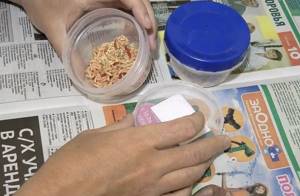
The principle of growing larvae in such a device is very simple and requires minimal human intervention. There is no need to look for what maggots eat, since everyone has everything they need at home.
Maggot works as follows:
- First, meat or fish is placed in the upper container, placed in a shaded place and left for 2-3 days so that the flies can find the egg and lay eggs;
- After the specified period, you need to check for the presence of eggs. If the flies managed to lay them aside, cover the container with a lid and put it in place;
- When maggots grow, they will strive to pupate. To do this, they will try to burrow deeper and begin to penetrate through the holes in the bottom of the container;
- After entering the middle container, maggots will penetrate through a layer of sawdust or shavings. As they overcome this layer, they will be cleaned, after which they will fall into the last container. They can be taken out of it and packaged in jars.
The growing time for bait varies from 7 to 10 days. This is influenced by air temperature and the rate at which blowflies lay eggs.
If a fisherman wants to get ready to go out to the pond quickly, he should figure out how to make a device for breeding maggots.
Using chicken eggs, you can quickly and easily stock up on larvae. Of course, you can’t make a business out of maggots this way, but you can get hold of a small amount of valuable bait. The process is simple:
- Hard-boil a large chicken egg, cool.
- Remove part of the shell (only from the top of the egg).
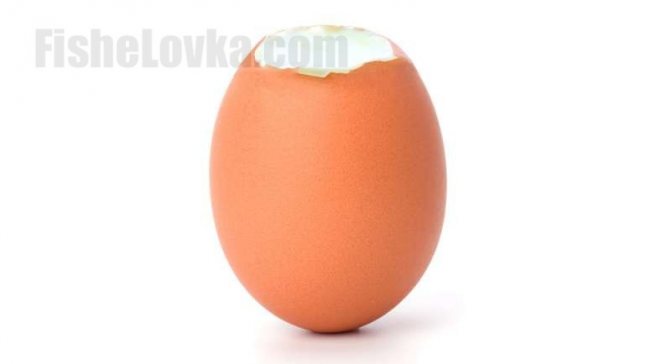
Photo 1. Prepared egg. - Place the chicken product in fresh air (preferably in a little shade).
- After 2 days (if it’s warm), the egg will go rotten, and a blue fly will certainly fly to the smell and lay a clutch.
- The larvae hatched in the egg are ready for fishing - the shell will not allow them to crawl.
This method of growing maggots at home is not bad, but only when you need a few larvae. Otherwise, you will have to stock up on a few rotten eggs.
Interesting! Do maggots reproduce? You should not expect an increase in their number - the larvae will not reproduce, only flies can emerge from them.
Methods for storing bait during the winter
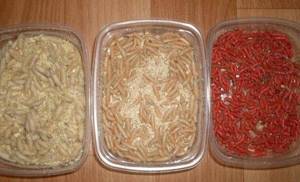
Winter storage of maggots at home is good because during this period the larvae can even be sent to the balcony. True, if night frosts are observed, you should take the container with “fish delicacies” to a warmer place. If a refrigerator is not suitable, it is necessary to build a special heated space. Simply put, this is a DIY container.
You can make the product this way:
- You need to take a tube with a small diameter - no more than 10 cm and solder it at one end.
- Next, you need to drive this product with its closed edge down into the ground about one and a half meters, but no less. The reason for this is that the frost line is higher up, so it won't work.
- After this, it will be necessary to make a tin cylinder with a bottom. Particular attention is paid to the diameter, which should be slightly smaller than the diameter of the pipe itself.
- Next, you will need to take foam plastic and cut out a cork from it.
Having built such a greenhouse, you can proceed to pouring maggots into a cylinder, which will need to be lowered into a pipe driven into the ground. To make it easier to pull out the cylinder, you will need to either attach rope handles to it, or do something similar, otherwise you will then have to work hard to somehow disassemble this entire structure. Having resolved this issue, the pipe is closed with a plug.
Thus, maggots are stored for a long time. When going fishing, all you need to do is open the boat and take out as many larvae as you need, and then hide them again in a fairly warm place.
Storing boiled maggots
The maggot is a rather finicky creature that is highly dependent on temperature and weather conditions.
Store maggots at a temperature close to 0°C. If the temperature exceeds this indicator, then over time the larvae will begin to die and simply deteriorate. This also works in the opposite direction - in very cold conditions the bait will simply freeze and will not cause any reaction in the fish. When purchasing larvae, you should remember that they do not live in the best conditions, so be sure to wash them thoroughly and leave them in a dry place for 30–40 minutes so that they can dry.
Bait for winter fishing needs to be grown at home starting in the fall. It is believed that larvae grown in such conditions are the most hardened for fishing. This is due to disruptions in the natural regime, so when they appear in the fall, their immunity becomes stronger.
The advantage of being cold outside is that you don’t have to worry about freeing up space in the refrigerator. During this period, the bait can be on the balcony or loggia. However, in severe frosts at night, it is recommended to take the container with maggots to a warmer place.
You can also create a container *heater* with your own hands:
- We take a plastic pipe with a diameter of 10-15 cm and a length of 1.5-2 m.
- You will also need polystyrene foam 3-4 cm thick. We cut it out like a cork, with which we close one of the ends of the pipe.
- We find a container, a coffee can, which should be slightly smaller than the diameter of the pipe.
- Cut out another foam plug for the cylinder.
- Next, fold the wire in half and bend the ends, pierce the plug in the middle and insert the folded wire so that the ends rest against the body of the lid. All this is so that we can open a jar of maggots without any problems.
- We make 2 small holes in the wall of the jar and tie two laces, a little higher we make a knot (which functions as a handle).
The heating unit is ready, now it needs to be installed. We bury a pipe with a closed end in the ground so that 10-15 cm sticks out of the ground. We pour maggot into the cylinder and lower it, and tie the string so as not to lose it. At the end of all procedures, the plug is tightly inserted into the pipe. Approximately what should happen is shown in the picture below.

Cover the heater too so that snow more than 1.5 meters high does not fall into the chimney.
Thanks to such actions, the bait lives for a long time. Before going fishing, just open the container and take out the required amount of bait, and then simply return the cap to its place.
Boiled larvae are better suited for summer fishing and are used for a narrow segment of fish.
The bait should be boiled in longitudinal water. After two/three minutes, the color of the larvae will begin to change and reach a transparent shade. This is a sign of readiness.
Afterwards the contents need to be cooled and dried. It is recommended to store all larvae in a linen bag with the addition of flour. After this, the future bait is left in a cold place until needed.
Experienced fishermen prefer to add color to the delicacy. They believe that the chance of catching fish will increase.
During the cooking process, “paint” is added to the water:
- For all shades of red – beets.
- The orange tint is obtained by adding onion peels. Nutritional supplements will also help.
- The yellow color is created by feeding boiled yolks.
The color can also be changed during the production of larvae. Maggots will turn white if you feed them with cottage cheese every day.
A temperature that is close to zero helps to keep the bait in a stable state, in which the slowdown of its vital processes slows down the time of transition to the pupation phase. Such conditions at home have already been created in the household refrigerator. All that remains is to prepare a tightly sealed container and determine the permanent location of the bait in the household appliance.
Maggot can also be stored in winter in unheated rooms where temperatures do not drop below -5 degrees. A balcony or garage can serve for these purposes. The larvae are mixed with sand or sawdust. In this form, they will survive the winter, and with the arrival of warmth they will return to life again and, after feeding, they will reach the previously existing conditions.
How to store boiled maggots
Few people know that you can also fish with boiled maggots. Fishermen note that such bait works well in the summer for certain types of fish. And if so, then why not take advantage of it.
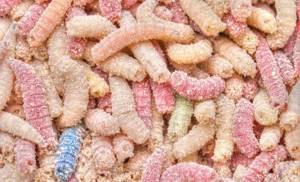
In order to cook maggot, you need to place it in a suitable container, add water, and after boiling, boil for several minutes. When the larvae acquire an almost transparent shade, this will mean that they are ready. Having taken them out and cooled, you can proceed to the next steps, which will make it possible to preserve the maggots in this state for some time.
To begin with, the larvae will need to be slightly dried, then placed in a linen bag and sprinkled with a little flour. Some fishermen do not do this and note that flour does not affect the quality of maggots in any way, so this step is done at will. Next, the treat is sent to a cold place.
Important! At high temperatures, boiled maggots will immediately spoil, so it is better to keep them in the refrigerator or on the balcony.
Some fishermen, in order to give color to the larvae, which will increase the chances of a good bite, paint boiled maggots at the preparation stage. It does not take a lot of time. If you want to make the larvae red, you can add a little beetroot to the pan. Onion peels will help with the orange color. Suitable for coloring and food coloring.
By the way, color can be achieved even at the stage of larval growth. By feeding the maggot, for example with cottage cheese, you will notice that over time it becomes whiter. At the same time, boiled yolks will contribute to the yellowing of the bait.
Regardless of whether the maggot is alive or boiled, it is still an excellent bait that many types of fish will enjoy eating.
Feeding maggots
Live maggots become pets because they need to be fed every day. A big plus is that they eat any food, so leftover food and food waste can pass for food.
You can also use a delicacy - cottage cheese. Most fishermen believe that it not only gives the larvae a white tint, but also makes them more attractive to predatory fish.
If the budget does not allow you to allocate delicacies for feeding “pets”, ordinary beets will do, they will give a scarlet tint and increase the nutritional value.
What do you feed maggots?
Live white worms can be a little more difficult because they need to be fed regularly. The advantage is that maggots eat a lot of different things. If there is any meat waste in the house in the form of trimmings, for example, then they can easily be fed to the larvae. The same applies to cottage cheese. If there is no desire to translate such products in vain, then ordinary beets are quite suitable.
Some fishermen manage to feed maggots with food coloring. So the larvae, firstly, change color, and secondly, they receive the necessary food. Opinions differ regarding this, so if you don’t want to take risks, then it’s better to throw some kind of edible waste to the larvae.
In conclusion, it must be said that storing maggots is not as difficult a task as it might seem at first glance.
Source: IaRybak.ru
What to feed maggots at home
